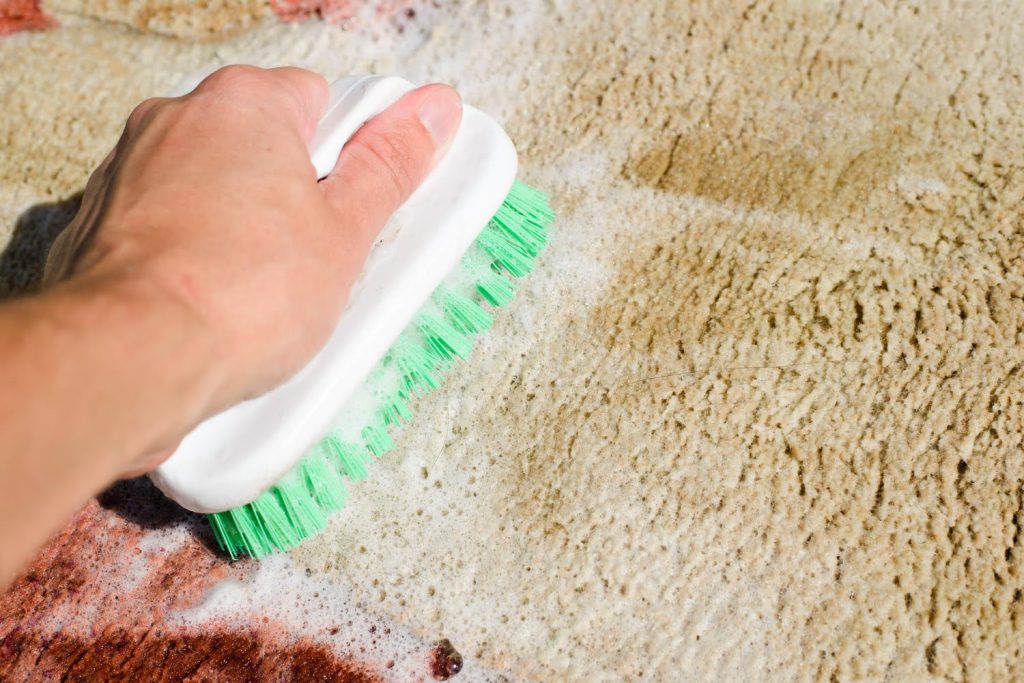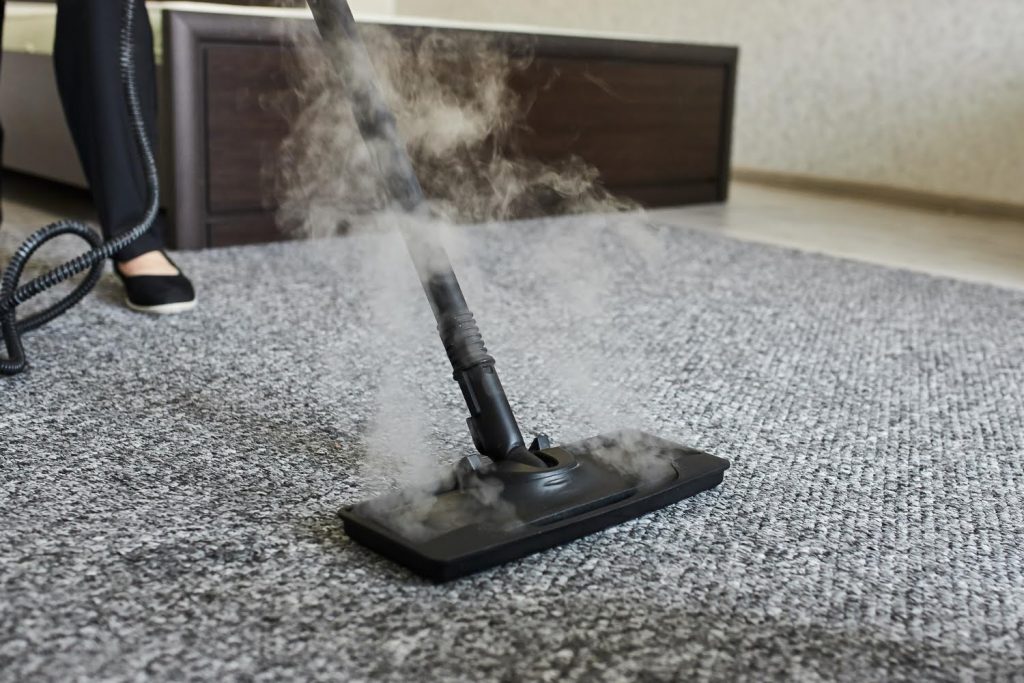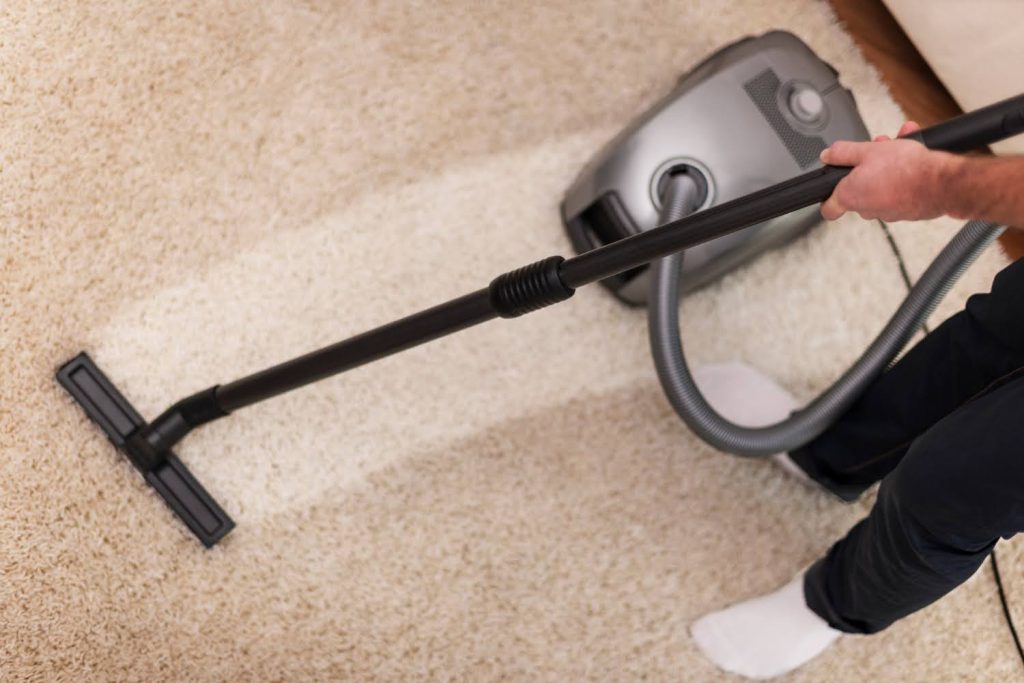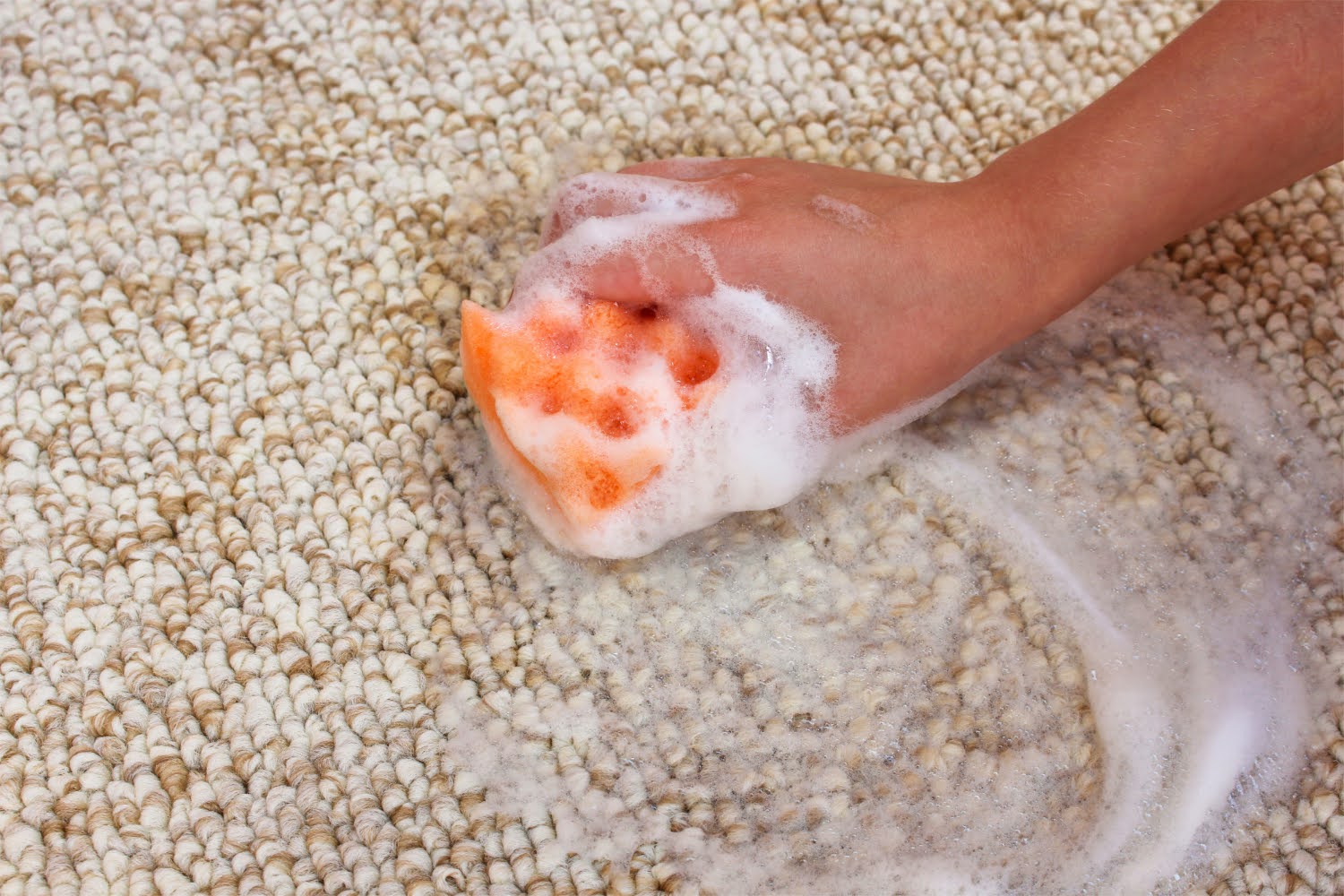The appearance and cleanliness of your carpet significantly impacts first impressions. Maintaining a clean and vibrant space enhances the overall aesthetic appeal and contributes to a healthier environment by reducing allergens and dust – and the carpet plays a huge role in this.
This guide delves into the essentials of carpet cleaning, emphasising the importance of this often-overlooked aspect in maintaining your commercial property’s image and hygiene.
This article explores the differences between steam cleaning vs shampooing carpet, discusses drying times, delves into various rinsing techniques and even touches on specialised treatments like flea control.

4 Reasons To Regularly Your Clean Carpets In Commercial Settings
Let’s explore four compelling reasons why regular carpet cleaning is necessary in commercial settings.
From enhancing the overall appearance of your business to ensuring a healthy environment for employees and customers, we will highlight the importance of maintaining clean carpets.
1. Enhances Appearance and Extends Lifespan
Regular carpet cleaning is crucial in maintaining the aesthetic appeal of a commercial space. A clean carpet presents a professional image to clients and visitors, positively portraying your business.
Moreover, regular cleaning prevents the buildup of dirt and debris, which can wear down carpet fibres over time, extending the carpet’s lifespan.
2. Improves Indoor Air Quality
Carpets trap pollutants like dust, pollen, and dander, which can degrade indoor air quality. Regular cleaning removes these pollutants, ensuring a healthier environment for employees and customers.
This is especially important in commercial settings where high foot traffic can rapidly accumulate contaminants.
3. Prevents Mould And Mildew Growth
In environments with high humidity, carpets risk developing mould and mildew if not properly maintained.
Regular cleaning and drying prevent the buildup of moisture in carpet fibres, thereby inhibiting the growth of mould and mildew, which can cause health issues and damage to the carpet.
4. Saves Money In The Long Run
Investing in regular carpet maintenance can save money for a business in the long run. By prolonging the life of your carpet, you reduce the frequency of costly replacements.
Additionally, regular upkeep helps avoid extensive deep cleanings, which can be more expensive and disruptive to business operations.
Steam Cleaning Vs Shampooing Carpet: Which Is Better For Your Commercial Property?
Maintaining clean carpets in a commercial setting requires choosing the right cleaning method. Shampooing and steam cleaning are two popular methods with unique approaches and benefits.
When evaluating steam cleaning versus shampooing for maintaining the carpets of a commercial property, it’s critical to delve into the nuances of each method’s efficiency, cost implications, and the quality of results they offer.
This detailed comparison can help property managers and business owners make informed decisions tailored to their circumstances.
Steam Cleaning (Hot Water Extraction):
- Efficiency: Steam cleaning uses high-pressure hot water to toss the carpet fibre and dissolve dirt in the carpet.
This method is particularly effective for deep cleaning most carpet fibres, including synthetic and delicate natural fibres like wool and silk, because it can remove more than just surface dirt.
It also removes bacteria, allergens, and dust mites deep within the carpet. It’s a preferred choice for environments that need to maintain a high standard of cleanliness and for carpets that are heavily soiled or have deep-set stains.
- Cost: Steam cleaning is generally higher than shampooing because it requires more sophisticated equipment and sometimes more specialised detergents. However, the investment can be cost-effective over time.
The thorough cleaning provided by steam cleaning can extend the lifespan of carpets by removing debris that can degrade the carpet fibres, potentially reducing the frequency of costly carpet replacements.
- Results: Steam cleaning is known for its ability to provide a deep clean that not only improves the appearance of carpets but also enhances indoor air quality by removing pollutants and allergens.
The drying time post-cleaning can be longer than shampooing, but modern techniques and equipment have significantly reduced drying times to make this less inconvenient.

Shampooing
Shampooing involves applying a detergent-based solution to the carpet, followed by using a machine that agitates the carpet fibres to loosen dirt and debris. The foam created captures the dirt, which is then vacuumed away.
- Efficiency: The method effectively removes surface dirt and stains on synthetic fibres like nylon and polyester, making carpets look visually clean and refreshed.
However, removing deeply embedded dirt, bacteria, and allergens might be less effective. It’s also less suitable for natural fibres like wool, as moisture and chemicals can damage these fibres.
- Cost: Shampooing is generally less expensive than steam cleaning in terms of the equipment used and the cost of cleaning solutions.
This can make it an attractive option for regular maintenance cleaning in commercial spaces that do not require deep cleaning as frequently.
- Results: While shampooing can leave carpets looking clean and smelling fresh, it has some downsides. The method can leave behind chemical residues that attract more dirt over time, leading to quicker carpet re-soiling.
Additionally, if the carpet is not thoroughly rinsed, the residue can become sticky and may lead to a deterioration in carpet appearance and texture over time.
The Carpet Cleaning Method Best Used For Each Type Of Commercial Property
The choice between steam cleaning and shampooing should be influenced by the specific needs and characteristics of the commercial property in question:
For High Traffic Areas
In environments such as retail spaces, schools, and airports, where there is a high footfall, steam cleaning is often the preferred method. Its ability to deeply clean and remove allergens and bacteria is crucial for maintaining a healthy environment for many people.
For Spaces With Lower Traffic
In commercial spaces like small offices or boutiques with lower foot traffic, shampooing might suffice for regular maintenance. However, even these spaces can benefit from the occasional deep clean provided by steam cleaning, especially in areas like entryways or common rooms that might see more use.
For Specialised Environments
Certain commercial properties, such as healthcare facilities, restaurants, and hotels, require a higher standard of cleanliness and hygiene.
Steam cleaning is generally recommended for these properties due to its superior ability to sanitise and deep clean.
Regular steam cleaning can help maintain a hygienic environment, which is critical in healthcare settings, and preserve the appearance and longevity of carpets in hotels and restaurants.

How To Rinse Carpet After Shampooing
Should You Rinse Carpet After Shampooing? Rinse or not rinse a carpet after shampooing is a debated topic, but rinsing is recommended for most commercial carpets, especially in high-traffic areas.
While some modern shampoos claim to leave minimal residue, rinsing ensures the complete removal of cleaning agents, thereby preventing rapid re-soiling and enhancing the carpet’s overall cleanliness and longevity.
It’s crucial to choose a rinsing method that aligns with the carpet’s type, and the cleaning regimen followed, as this can significantly influence the maintenance of the carpet’s optimal cleanliness and appearance.
Rinsing your carpet after shampooing is a critical step in the cleaning process. It removes any remaining dirt and cleaning solution, ensuring your carpet is clean and maintains its quality and longevity.
1. Prepare The Area And Vacuum Thoroughly
Clear the carpet area of furniture or obstacles for unhindered access, ensuring a thorough rinse across the entire surface.
Begin by vacuuming to remove any loose dirt. This step is essential for effective rinsing and maintaining the carpet’s texture and appearance.
2. Mix Rinsing Solution (If Needed)
If a rinsing solution is required, mix it as instructed. Often, using plain water is adequate, but in some cases, a mild, carpet-safe detergent might be necessary.
3. Use A Carpet Rinser Or Wet Vacuum
Fill a carpet cleaning machine or wet vacuum with clean, lukewarm water. Be cautious not to use excessive water, as it can penetrate deep into the carpet backing and padding, potentially causing mould and mildew.
4. Apply Water/Solution Evenly
Methodically cover the carpet, starting from one corner and moving across. This ensures no missed areas and the carpet’s texture is uniformly restored. Remember, use clean water to prevent dirt from being re-deposited onto the carpet. This step ensures that the carpet remains clean and vibrant post-rinsing.
5. Extract The Water
After application, thoroughly extract the moisture using a wet vacuum. Choose a vacuum with sufficient suction power to remove water and clean residue effectively, preventing re-soiling and discolouration.
6. Inspect And Repeat If Necessary
Check the carpet for any spots that may require additional attention. A thorough rinse is crucial to prevent residue build-up, which can damage the fibres.
7. Thoroughly Dry The Carpet Plus Final Vacuuming
Employ fans, air movers, or dehumidifiers to expedite drying. Ensure the carpet dries completely to avoid any potential mould growth. Once dry, a final vacuuming session helps remove any lingering dirt and enhances the carpet’s texture, ensuring it looks and feels refreshed.
How Long Does A Carpet Take to Dry After Shampooing?
Commercial carpets take about 6-10 hours to dry after shampooing. However, in certain conditions, such as cooler temperatures or high humidity, it can take up to 24 hours.
Understanding the drying time of carpets post-shampooing is crucial for planning and ensuring the area is back in use as soon as possible.
Various factors can influence this drying period, and knowing them can help in managing your expectations and planning accordingly.
1. Humidity Levels
The moisture content in the air plays a significant role in drying time.
In high humidity conditions, such as in coastal regions or during rainy seasons, the air is already saturated with moisture, slowing down the evaporation process from the carpet.
Conversely, lower humidity can speed up drying in arid regions or air-conditioned indoor environments.
2. Carpet Type and Thickness
The material and density of the carpet fibres affect how much moisture they can absorb and retain. Thicker carpets, often found in luxury hotels or high-end offices, tend to hold more water and thus take longer to dry than thinner, more utilitarian carpets used in retail spaces or standard offices.
3. Air Circulation
Effective air circulation is key to quick drying. In open-plan commercial spaces, such as showrooms or large offices with open windows or efficient HVAC systems, the increased air movement helps evaporate moisture faster.
In contrast, smaller, enclosed spaces like individual hotel rooms or conference rooms with limited ventilation may experience longer drying times.
4. Cleaning Method Used
Different carpet cleaning methods use varying amounts of water. For instance, a deep steam cleaning might saturate the carpet more than a surface-level shampooing or bonnet cleaning method.
Thus, carpets requiring more intensive cleaning could have longer drying periods in high-traffic areas like lobbies or corridors.

Tips For Speeding Up The Drying Process
Here are some tips to speed up the drying process of wet carpet:
1. Enhance Air Circulation
Use commercial-grade fans or air movers strategically placed around the room to promote better air circulation. This is particularly effective in enclosed spaces. Positioning fans near open doors or windows can help draw in fresh air and expedite the drying process.
2. Utilise Dehumidifiers
In humid environments or during wet seasons, dehumidifiers can be crucial in reducing the moisture level in the air. By removing excess humidity, these devices help the carpet to dry faster.
3. Increase Room Temperature
Slightly raising the temperature in the room can speed up the evaporation process. This can be done using the building’s heating system or portable heaters, ensuring they are used safely and not placed too close to the carpet.
4. Use Carpet Dryers or Blowers
Carpet dryers or blowers, which are more powerful than regular fans, can significantly reduce drying time. These are especially useful in large commercial spaces or areas with thick carpeting.
5. Avoid Over-Wetting During Cleaning
Be cautious with the amount of water used during the cleaning process. Over-wetting can extend drying times unnecessarily. Using efficient cleaning techniques and equipment can help control the moisture applied.
Conclusion About Steam Cleaning Vs Shampooing A Carpet
Selecting a cleaning method that aligns with your carpet’s material and the specific needs of your commercial space. While steam cleaning offers deep cleansing and sanitisation, shampooing can be sufficient for regular maintenance and surface-level cleaning.
The choice should consider the carpet’s fabric, the level of foot traffic, and the type of dirt or stains being addressed.
ESP Cleaning Services is here to help those seeking professional guidance or services. With a team of experienced professionals equipped with state-of-the-art tools and knowledge, we guarantee a level of service that meets your highest expectations.
Whether you require routine maintenance, deep cleaning, or specialised treatments, we are ready to provide solutions tailored to your needs.
Frequently Asked Questions About Steam Cleaning Vs Shampooing Carpet
Will Shampooing Carpet Kill Fleas?
Shampooing a carpet can aid in reducing flea populations by cleaning and removing eggs, larvae, and adult fleas from the fibres.
Still, it may not be completely effective in eradicating all stages of fleas. Using flea-specific treatments in conjunction with shampooing is advisable for more comprehensive flea control.
Additionally, regular vacuuming and treating pets with veterinarian-recommended flea control products are crucial in effectively managing flea infestations in carpets.
Do Professional Carpet Cleaning Services Use Harsh Chemicals That Could Damage My Carpet Or Harm The Environment?
Reputable professional commercial cleaning services prioritise using eco-friendly and carpet-safe cleaning solutions.
Whether opting for steam cleaning or shampooing, these professionals can select the most appropriate and gentle cleaning agents for your carpet type, ensuring effective cleaning without compromising environmental safety or carpet integrity.
Can Professional Carpet Cleaning Be Done After Hours To Avoid Disruption In My Business Operations?
Many professional cleaning services offer flexible scheduling, including after-hours appointments, to minimise disruption to your business operations.
Discuss your needs with the service provider to arrange cleaning during off-peak hours, ensuring your business can continue operating without interruptions.
How Far In Advance Do I Need To Schedule Professional Carpet Cleaning?
Planning ahead is key when scheduling professional carpet cleaning services.
It’s recommended to book at least two weeks in advance, especially during peak seasons like spring and fall, to ensure you get a slot that suits your schedule.
However, some companies may accommodate last-minute requests based on availability.

